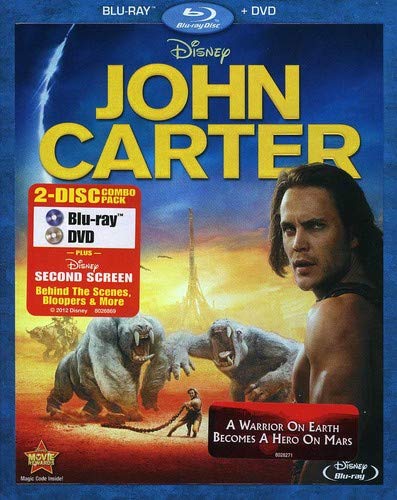
Written by Max Naylor
You can run into a lot of problems trying to update a 100-year-old science fiction serial about a Civil War veteran who finds himself transported to inhabited, life-sustainable Mars, not the least of which is that most members of a modern audience are reasonably sure Mars is, in fact, uninhabited.
We’re not talking “there may be civilizations underground,” but straight-ahead “there are warring factions on the surface of the planet that battle monstrous aliens and flying spaceships alike.” These are the kinds of concepts that really put a director’s ability to suspend disbelief to the test.
It’s an amazing thing, therefore, that writer/director Andrew Stanton (the Pixar native who directed Wall•E and Finding Nemo) has been able to bring the Barsoom stories of Edgar Rice Burroughs to the screen in such a fantastic, larger-than-life manner with nothing being lost in translation as John Carter. The first-time live-action director, probably drawing from his vast experience with animated films, truly transports the audience not to some halfway bargain of a Mars that somehow fits the actual planet, but this fantasy landscape that existed only in the mind of one fiction writer a century ago, and is now with us in film format.
In fact, the most unbelievable thing about the entire movie is the underwhelming performances of its two lead actors: Taylor Kitsch as the eponymous Carter, and Lynn Collins as his genius scientist Martian-princess love interest (I’m not kidding). There were some great performances from some truly talented actors, like Willam Dafoe’s turn as a warlord Martian, Dominic West as a… different kind of warlord Martian, and some form of HBO’s Rome reunion with both Ciarán Hinds and James Prefoy, all of whom shine in their individual, tangential, wasted roles. Meanwhile the main roles were doled out to a couple of twenty-somethings who seemed too scared of the possibility of wrinkles to risk facial expressions. For the two characters who are supposed to carry the film, it seemed like the casting department didn’t think much beyond getting a couple cuts of meat that would look good in the window.
But let’s be honest: No one is buying a ticket to John Carter to see the next ground-breaking film of the century. No one expected something that would change the way we look at movies and make us fall in love again. We wanted a decent storyline and some bone-deep, white-hot alien carnage. And in that, …Carter is happy to deliver.
I’ve never really been one to scream at people, “Oh you have to see the Blu-ray.” Film’s an experience, and God knows we were watching movies on scratchy, blippy VHSs before anything digital came along, and I’m sure in 20 years we’ll be talking about what cavemen we all were to ever stoop so low as to watch anything on less than full sens-o-surround with holographic smells, but if you’re going to see a movie for the effects (as, watching John Carter, we are) the format really lends a lot to the material. It’s a ton of fun seeing the motion-captured Tharks (the tusked “native” Martians) emote, and the landscapes they gleaned from the stories are bright and majestic as anything that John Ford ever shot and then put through some eldritch Frazetta-izer. There were really only one or two sequences where I think the high definition may have betrayed them a bit and the scenes came across as less-than-realistic-looking, but all the visceral visuals we expect to see in an action/sci-fi movie are in attendance in their dress blues.
I was especially impressed with Stanton’s ability to somehow piecemeal a large collection of these stories into a two-hour three-act plotline, which he does exceedingly well. It helps to ward off feelings of dissatisfaction with an adaptation when, by definition, you can’t directly adapt the original. Stanton was forced, in writing this, to find the film in an extensive and varied master work, and he did an excellent job in separating the wheat from the chaff, cherry-picking exactly which parts would fit together well-enough to constitute a well-structured, well-written (if not particularly well-acted) adventure flick.
As for the Blu-ray itself, I was a little let down by the bonus features. Apart from an interesting retrospective on Burroughs himself and his history in writing and how the film eventually went into production (which is, as the title of the feature refers to, a process that has taken about a century) there’s really nothing more than a blooper reel and a making-of featurette which focuses largely on how special effects work and what a day of shooting on set is like.
I think, by now, most avid making-of watchers are familiar with the fact that, yes, green screens exist and, yes, there are lots of extras that work long hours. There was so much more going on technically with this film that I would have loved to hear about: the creation of the Tharks or the design behind the costuming. There’s a new option called Disney Second Screen which allows you to synch your tablet or phone up with an app you download for free from Disney, and then as you watch the film it talk about different aspects of whatever’s on screen and fills you in on those technical details, but I would think it would be much too distracting the first time through and, as much as I think the film delivers as a roaring space-aged hoot, I don’t think sitting through it a second time simply to see Willam Dafoe on stilts would be worth it.
In its genre, John Carter gives you exactly what you’re expecting to see, so don’t get the Blu-ray thinking you’re holding the next A Clockwork Orange, just check out some neat-looking Martians blowing up other less-neat-looking Martians and, if you must, ogle the lead cast a little. I assure you, I’ve seen the Rover photos. Exploding aliens, while maybe not as fascinating, is a lot more fun.